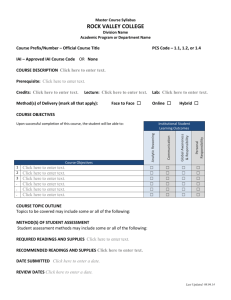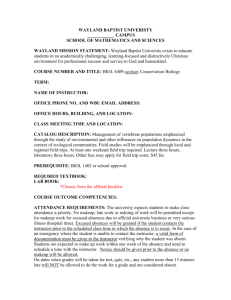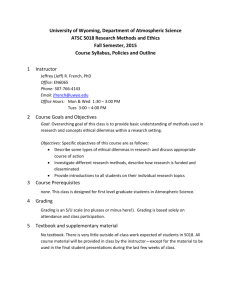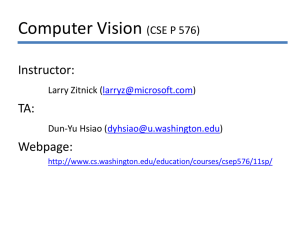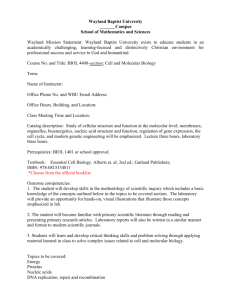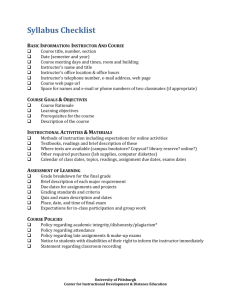Computer Vision Course Syllabus - CS 691W
advertisement
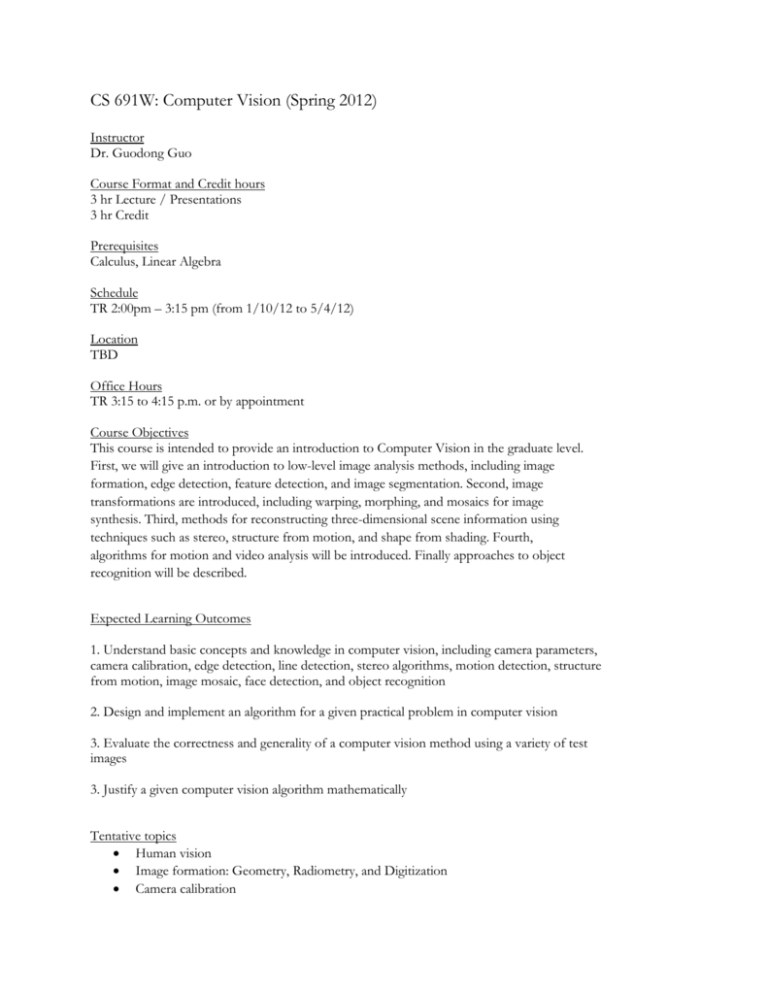
CS 691W: Computer Vision (Spring 2012) Instructor Dr. Guodong Guo Course Format and Credit hours 3 hr Lecture / Presentations 3 hr Credit Prerequisites Calculus, Linear Algebra Schedule TR 2:00pm – 3:15 pm (from 1/10/12 to 5/4/12) Location TBD Office Hours TR 3:15 to 4:15 p.m. or by appointment Course Objectives This course is intended to provide an introduction to Computer Vision in the graduate level. First, we will give an introduction to low-level image analysis methods, including image formation, edge detection, feature detection, and image segmentation. Second, image transformations are introduced, including warping, morphing, and mosaics for image synthesis. Third, methods for reconstructing three-dimensional scene information using techniques such as stereo, structure from motion, and shape from shading. Fourth, algorithms for motion and video analysis will be introduced. Finally approaches to object recognition will be described. Expected Learning Outcomes 1. Understand basic concepts and knowledge in computer vision, including camera parameters, camera calibration, edge detection, line detection, stereo algorithms, motion detection, structure from motion, image mosaic, face detection, and object recognition 2. Design and implement an algorithm for a given practical problem in computer vision 3. Evaluate the correctness and generality of a computer vision method using a variety of test images 3. Justify a given computer vision algorithm mathematically Tentative topics Human vision Image formation: Geometry, Radiometry, and Digitization Camera calibration Image segmentation: Region-based and edge-based Image processing for feature: Edge detection, line and curve detection, snakes, and filtering Stereo Shape from X: Shape from shading, photometric stereo Image-based modeling and rendering Motion analysis: Motion detection and optical flow, structure from motion Object recognition: Model-based, appearance-based, and invariant features Face detection and recognition Recent advances and research topics in Computer Vision Grading Homework and Programming Assignments (40%) 1 Mid-term (40%) Final Project (20%) Extra (1~10%, for creative ideas, paper submission based on this course, etc.) Programming Languages Matlab and C/C++ Textbook Computer Vision: Algorithms and Applications, Richard Szeliski, http://szeliski.org/Book/ Optional Books Computer Vision: A Modern Approach by D. A. Forsyth and J. Ponce, Prentice Hall, 2003. ISBN-10: 0-13085198-1 Introductory Techniques for 3-D Computer Vision, E. Trucco and A. Verri, Prentice Hall, 1998. ISBN 013-261108-2 Grading Policy No make-up exams except by prior arrangement with instructor Late assignment = no assignment Exam grading appeals in writing on the day the exam is returned. Attendance Policy Consistent with WVU guidelines, students absent from regularly scheduled examinations because of authorized University activities will have the opportunity to take them at an alternate time. Make-up exams for absences due to any other reason will be at the discretion of the instructor. Social Justice Statement West Virginia is committed to social justice. I concur with that commitment and expect to maintain a positive learning environment based upon open communication, mutual respect, and nondiscrimination. Our University does not discriminate on the basis of race, sex, age, disability, veteran status, religion, sexual orientation, color or national origin. Any suggestions as to how to further such a positive and open environment in this class will be appreciated and given serious consideration. If you are a person with a disability and anticipate needing any type of accommodation in order to participate in this class. Please advise me and make appropriate arrangement with Disability Services (293-6700). Integrity Statement The integrity of the classes offered by any academic institution solidifies the foundation of its mission and cannot be sacrificed to expediency, ignorance, or blatant fraud. Therefore, I will enforce rigorous standards of academic integrity in all aspects and assignments of this course. For the detailed policy of West Virginia University regarding the definitions of acts considered to fall under academic dishonesty and possible ensuing sanctions, please see the Student Conduct Code at http://www.arc.wvu.edu/admissions/integrity.html. Should you have any questions about possibly improper research citations or references, or any other activity that may be interpreted as an attempt at academic dishonesty, please see me before the assignment is due to discuss the matter.

